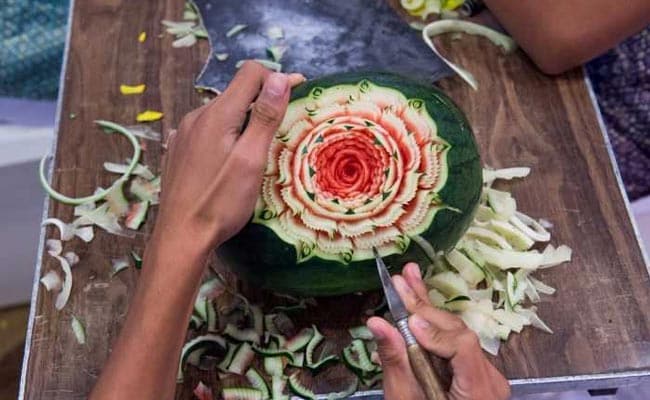Have you ever seen a beautifully carved fruit display and wondered how it was made? Well, get ready to be amazed because today we’re going to talk about the unique Thai art of fruit carving. This ancient technique, known as “kae sa lak” in Thai, has been practiced for centuries and is truly a visual feast for the eyes. In this article, we’ll take a closer look at the history and significance of fruit carving in Thai culture, as well as the intricate methods and tools used by artists to create these stunning masterpieces. So, if you’re ready to discover the beauty and artistry of Thai fruit carving, then keep reading!
In Thailand, fruit carving is more than just a decorative skill – it’s an important part of their culture and traditions. Dating back to the 14th century, fruit carving initially served a ceremonial purpose, with intricately carved fruits being presented as offerings to Buddhist monks. Over time, this art form evolved and became appreciated for its aesthetic value as well. Nowadays, you can find beautifully carved fruits adorning tables at special events, festivals, and even in luxurious hotels and restaurants.
Thai fruit carving is a meticulous process that requires a steady hand and a lot of patience. Artists start by selecting fresh and ripe fruits like watermelons, pineapples, and even cucumbers. They then carefully peel and carve these fruits into intricate patterns, flowers, and shapes using various specialized tools like knives, melon ballers, and vegetable peelers. The result is a stunning creation that not only looks amazing but can also be enjoyed as a delicious treat.
Intrigued to learn more about Thai fruit carving? Well, in our next article, we’ll dive deeper into the techniques used by Thai fruit carving artists and explore the various styles and designs they create. We’ll also discuss the cultural significance behind these intricate creations and how they have become a symbol of Thai hospitality. So stay tuned and prepare to be captivated by the unique artistry of Thai fruit carving!
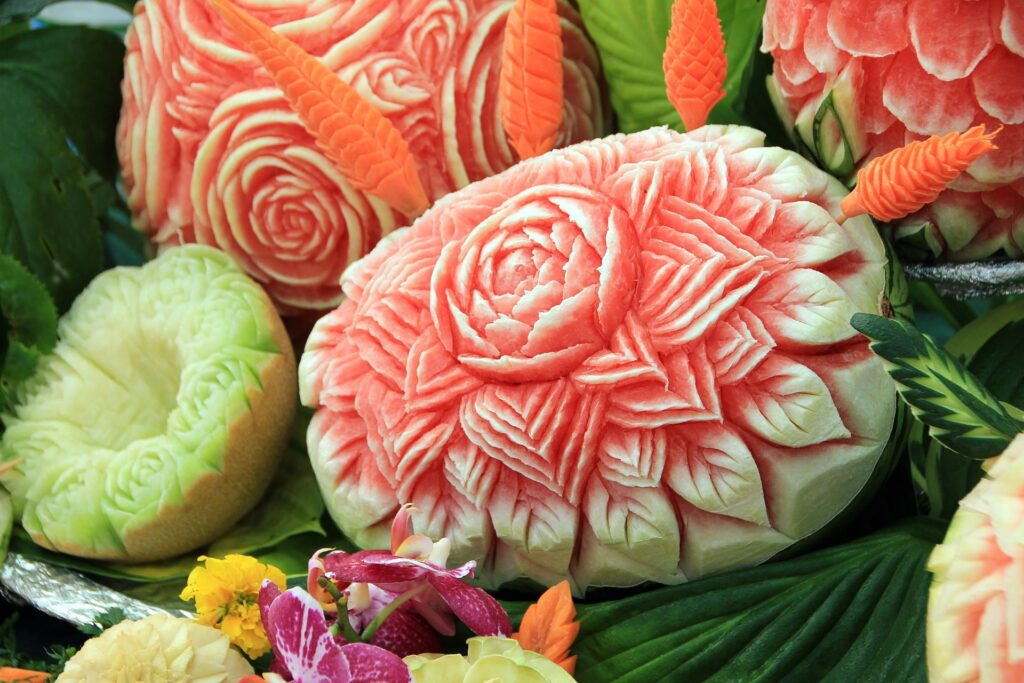
Introduction
Welcome to the world of Thai fruit carving, where fruits are transformed into exquisite works of art. This ancient craft has captivated people for centuries with its intricacy and beauty. In this article, you will discover the history and origins of Thai fruit carving, the materials and tools used, various techniques employed by the master carvers, symbolic representations in the art, traditional designs, contemporary approaches, cultural significance, and efforts to preserve and promote this unique craft.
The Beauty of Thai Fruit Carving
Thai fruit carving, also known as “kae sa lak,” is a traditional art form that combines the elegance of fruit with the skillful hands of artisans. It is a feast for the eyes, captivating viewers with its delicate and intricate designs. Thai fruit carving has become synonymous with Thai culture, reflecting the country’s rich traditions and creativity.
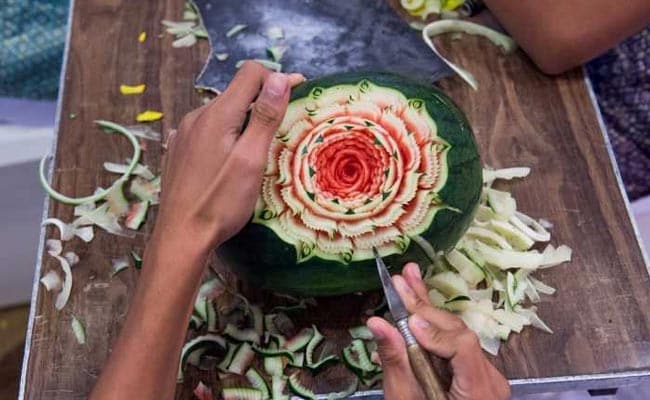
History and Origins of Thai Fruit Carving
Thai fruit carving has a deep-rooted history, dating back to the 14th century during the ancient kingdom of Sukhothai. It was believed to have been influenced by the Chinese art of fruit carving, brought to Thailand by Chinese traders. Over time, Thai artisans adapted and transformed this art form to create their unique style and techniques.
Materials and Tools
To create stunning fruit carvings, traditional Thai artisans use a variety of tools. These include small knives with different blade shapes, such as curved and pointed blades, as well as hooks and v-shaped tools for intricate detailing. In terms of materials, fruits with firm flesh and vibrant colors are preferred, such as watermelons, pineapples, papayas, and carrots.
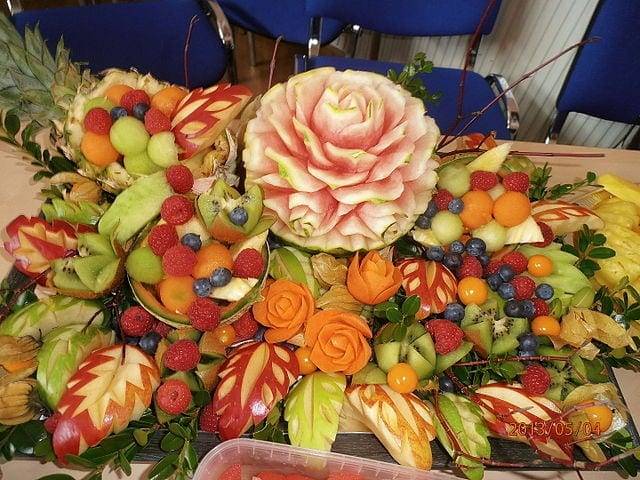
Techniques
Thai fruit carving involves a range of techniques, from basic carving to creating intricate designs and patterns. The process starts with selecting the right fruit, ensuring it is ripe and suitable for carving. The fruit is then carefully peeled, and the outer layer is skillfully removed to reveal the smooth edible core. Basic carving techniques, such as slicing, shaping, and peeling, are employed to bring the desired form to life. The artisans then move on to more complex patterns and designs, carefully etching and sculpting the fruit with precision and finesse.
Symbolism and Meaning
Thai fruit carving is not just about aesthetics; it carries deep symbolism and meaning. Each design and motif represents different aspects of Thai culture and beliefs. For example, the lotus flower symbolizes purity and enlightenment, while the elephant is a symbol of strength and power. These symbolic representations add depth and significance to the art form, making it more than just a decorative craft.
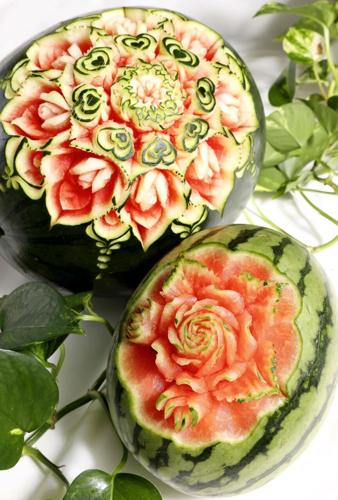
Traditional Thai Fruit Carving Designs
Several traditional designs are commonly found in Thai fruit carving. The lotus flower, with its graceful petals and intricate details, is a popular choice. It represents beauty, purity, and spiritual enlightenment in Thai culture. The elephant, being a sacred animal in Thailand, is often carved to pay homage to its significance. The peacock, known for its vibrant and mesmerizing feathers, symbolizes prosperity and good fortune. Other traditional designs include the dragon, which represents power and protection, and Thai mythological figures that depict ancient tales and legends.
Contemporary Approaches
While traditional designs continue to be cherished, contemporary approaches to Thai fruit carving have emerged in recent times. Innovation and modernization have allowed artists to experiment with new techniques and styles. Some artisans combine Thai fruit carving with other art forms, such as sculpture and painting, creating unique and innovative pieces. This blending of traditional and modern influences has pushed the boundaries of the art, showcasing the versatility and creative potential of Thai fruit carving.
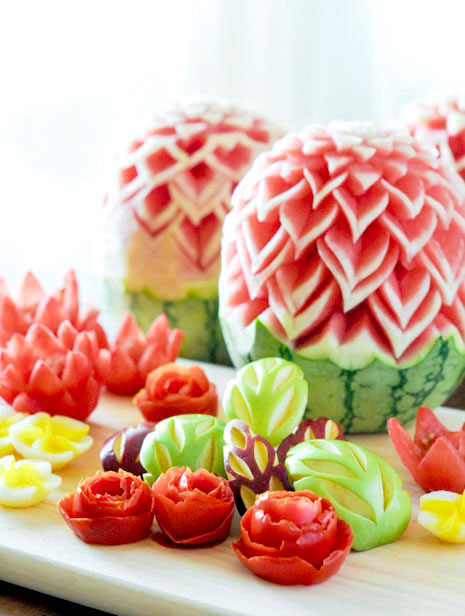
Cultural Significance
Thai fruit carving plays a significant role in Thai culture, particularly during celebratory events and occasions. It is often showcased during festivals, weddings, and religious ceremonies as a symbol of hospitality and abundance. Fruit carvings are offered as a gesture of respect and are believed to bring good luck and prosperity. The art form also exemplifies the importance of beauty and aesthetics in Thai culture.
Master Carvers
Throughout history, Thailand has produced numerous master carvers who have excelled in Thai fruit carving. Their contributions and achievements have elevated the craft to new heights. One such renowned artist is Nittaya Tardthong, considered a trailblazer in Thai fruit carving. Her intricate and breathtaking designs have earned her international acclaim. Other notable master carvers include Sanan Sirisukprasert, Pairoj Nuantong, and Saewataporn Wongpattasil.
Preserving and Sharing Thai Fruit Carving
Efforts are being made to conserve and promote Thai fruit carving, ensuring its survival for future generations. Various organizations and workshops have been established to teach the art form, passing down the skills and techniques to younger artists. These initiatives also aim to raise awareness about Thai fruit carving’s cultural significance and encourage its inclusion in the global art scene.
Conclusion
Thai fruit carving is more than just an art form; it is a visual feast for the senses. The attention to detail, the intricate designs, and the symbolic representations make it a truly remarkable craft. Through the centuries, Thai fruit carving has evolved, adapting to modern influences while staying true to its cultural roots. Its enduring allure continues to captivate and inspire people worldwide. So the next time you encounter a beautifully carved piece of fruit, take a moment to appreciate the artistry and skill behind it—a testament to the timeless beauty of Thai fruit carving.
